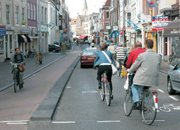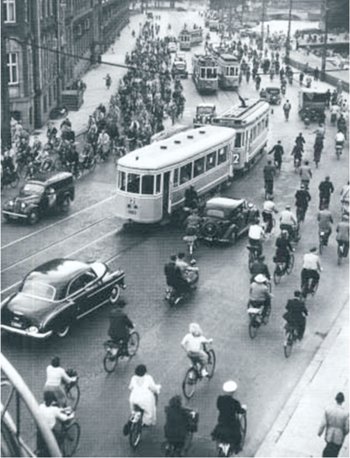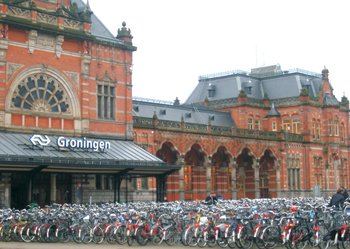Transport planners around the world have now more or less come to the conclusion that in order to address the issues that plague cities – congestion, pollution, road accidents, loss of open spaces/green cover – it is essential that sustainable modes – walking, cycling and public transport – be actively promoted. Growth of personal motorised vehicles namely, two-wheelers and cars, also has to be controlled through a variety of Transport Demand Management (TDM) mechanisms.
The Government of India has taken important steps to ensure that greater investments are made to improve public transport in cities and the conditions for walking and cycling.
The Importance of Cycling
 Cycling has always been a common mode of transport, especially in cities. Even today, in spite of its decline, it serves a large number of diverse users all of whom depend on cycling to get around; informal sector workers, domestic workers, postal employees, hawkers/vendors, school & college students, various delivery services (newspapers, milk, laundry, food (dabbawalas), gas cylinders) etc. So unlike other developed cities around the world, Indian cities have a large segment of population using cycles and there is a need to ensure their safety and convenience. At the same time, the challenge is also how to attract “choice users” – those who have a choice of driving. This segment of potential cyclists is also keen to cycle for its health benefits.
Cycling has always been a common mode of transport, especially in cities. Even today, in spite of its decline, it serves a large number of diverse users all of whom depend on cycling to get around; informal sector workers, domestic workers, postal employees, hawkers/vendors, school & college students, various delivery services (newspapers, milk, laundry, food (dabbawalas), gas cylinders) etc. So unlike other developed cities around the world, Indian cities have a large segment of population using cycles and there is a need to ensure their safety and convenience. At the same time, the challenge is also how to attract “choice users” – those who have a choice of driving. This segment of potential cyclists is also keen to cycle for its health benefits.
There are many reasons why cycling is being and should be considered a serious, not just a recreational, mode of transport in urban areas. Cycles occupy little space, generate no pollution and make the streets safe. But more importantly, most trips in a city are cycleable – almost 50% of trips are less than 7-8km, an easily cycleable distance. Proper planning can ensure that even as the city grows, trip lengths remain reasonable so that most people can still walk and cycle for many of their tasks such as shopping, recreation etc. Put another way, automobile-centric planning tends to create urban sprawl which then makes it necessary to drive, while sustainable transport planning encourages compact cities. Indian cities are still for the main part quite compact and hence still very conducive for walking and cycling.
The modern cycle and the modern automobile both first appeared at almost the same time around 1885. So the cycle is not an “outdated” mode of transport.
Creating a Cycle Friendly City
 Planning, Design and Technical Challenges
Planning, Design and Technical Challenges
In order to promote cycling in cities, it is not enough just to a build a few random cycle tracks. People will prefer to cycle in large numbers only if cycling is more convenient and safe as compared to other modes.
The aim therefore has to be to create a “cycle-friendly” city, a city in which anyone, quite naturally, would consider cycling as a way of getting around. This requires detailed planning, sophisticated designs and solutions to sometimes technically difficult problems.
A city bicycle policy and master plan
 The first step towards a cycle-friendly city is the need for a city policy for bicycling. This lays out the overall vision and sets specific goals for cycling. It also has a roadmap for how to accomplish these goals, projects and investments. Having basic data such as cycle O-D (origin-destination) mapping and modal share (how many people use cycles compared to other modes) is a pre-requisite for proper planning. This data has to be updated on a regular basis.
The first step towards a cycle-friendly city is the need for a city policy for bicycling. This lays out the overall vision and sets specific goals for cycling. It also has a roadmap for how to accomplish these goals, projects and investments. Having basic data such as cycle O-D (origin-destination) mapping and modal share (how many people use cycles compared to other modes) is a pre-requisite for proper planning. This data has to be updated on a regular basis.
The city also needs to carefully evaluate all road/transport projects and be cognizant of their impacts on cycling. Flyovers, signal-free roads, one-way streets can all make the situation more difficult for cyclists and care must be taken to avoid such options all together or specific provisions have to be made – for instance a counter-flow cycle track – to mitigate the impact on cyclists.
A cycle network
A cycle network is a combination of both cycle tracks as well as cycle-safe streets. Cycle friendly streets are essentially all streets that do not have a dedicated cycle track, but are still safe for cycling. This is done by traffic-calming – reducing the speeds and volumes of motorised traffic so that cyclists are safe. Many Indian cities have old city areas, which are usually congested and have narrow streets, and are actually better for cycling as speeds are slow and these areas can be converted to cycle safe zones. Some areas can even be converted into vehicle-free zones. Recreational cycling areas, in parks, along rivers and lakes and cycling trails in hills/forests are all part of such a cycle network. Dutch cities have expanded the cycle networks over the years.
Bicycle Parking
 An often forgotten component that is crucial to making cycling convenient and safe is to create ample and dedicated bicycle parking facilities. The poor are often as worried about the safety of their cycles as those with fancy cycles, as it represents a sizeable investment. Strategically placed bicycle parking facilities in public buildings, markets and close to public transport hubs can substantially reduce the time to complete the trip and hence encourage people to cycle.
An often forgotten component that is crucial to making cycling convenient and safe is to create ample and dedicated bicycle parking facilities. The poor are often as worried about the safety of their cycles as those with fancy cycles, as it represents a sizeable investment. Strategically placed bicycle parking facilities in public buildings, markets and close to public transport hubs can substantially reduce the time to complete the trip and hence encourage people to cycle.
As per a survey conducted by the Copenhagen Traffic Dept. 55% of Copenhageners cycle because it is faster than other modes and 33% said they choose to cycle because it is convenient.
Public Bicycle Schemes
 Started as an experiment in the 60s, Bike Sharing Schemes have a come a long way since and many cities have very extensive systems that serve as an alternative public transport mode. It consists of cycle stations scattered across the city where members can pick-up a cycle, ride it and return it to any other station. This allows people access to cycles where they need it, when they need it and for as long as they need it. It helps to solve the last-mile connectivity from and to public transport hubs.
Started as an experiment in the 60s, Bike Sharing Schemes have a come a long way since and many cities have very extensive systems that serve as an alternative public transport mode. It consists of cycle stations scattered across the city where members can pick-up a cycle, ride it and return it to any other station. This allows people access to cycles where they need it, when they need it and for as long as they need it. It helps to solve the last-mile connectivity from and to public transport hubs.
Bicycle Promotion
All cities that are actively promoting the use of cycles also plan events that help generate interest in cycling. Car-free days are gaining popularity, on such days residents can explore other ways to get around in the city including cycling. Cycle-to-School programs encourage children to ride bicycles to school. Cycle rallies and Critical Mass Rides all help to continually raise awareness about and visibility of cycling.
Technical Capacity
Cre ating cycle friendly infrastructure is not easy. Cyclists are very sensitive to cycling conditions – safety, continuity and comfort are essential to attract cyclists. Cycle tracks have to be meticulously designed with attention to every detail. At junctions, cyclists need to be given priority and safe passage – this can be done using special cycle traffic signals, cycle boxes and junction designs that reduce the chance of conflict between motorized traffic and cyclists. Various designs are possible for cycle tracks as well as choice of materials for their construction. Total street designs that create shaded cycle tracks are especially important in a hot country like ours. Policies that lead to indiscriminate road widening and tree felling make the road less conducive to cycling and should be avoided if cycling is to be encouraged.
ating cycle friendly infrastructure is not easy. Cyclists are very sensitive to cycling conditions – safety, continuity and comfort are essential to attract cyclists. Cycle tracks have to be meticulously designed with attention to every detail. At junctions, cyclists need to be given priority and safe passage – this can be done using special cycle traffic signals, cycle boxes and junction designs that reduce the chance of conflict between motorized traffic and cyclists. Various designs are possible for cycle tracks as well as choice of materials for their construction. Total street designs that create shaded cycle tracks are especially important in a hot country like ours. Policies that lead to indiscriminate road widening and tree felling make the road less conducive to cycling and should be avoided if cycling is to be encouraged.
Constant evaluation of the cycling infrastructure, cyclist surveys to find out their satisfaction levels and problems they face are on-going activities that must be performed by the city and will help to continually improve the conditions and encourage more and more people to use cycles. In order to develop this capacity and put in place the various systems/processes, it is important to have a special department in the city municipality within dedicated personnel and budget allocation.
Need for technical expertise
If public authorities are to plan for more cycle friendly cities they will need to rely on professional expertise. Unfortunately there are very few agencies that have experience in planning and engineering know-how in this area. It is therefore essential that existing transport infrastructure providers and engineering companies develop these competencies. There is much to be learnt from other cities, but ultimately solutions that are appropriate for Indian road conditions and users will have to emerge.
 Ranjit Gadgil
Parisar (NGO), Pune
Ranjit Gadgil
Parisar (NGO), Pune
 TrafficInfraTech Magazine Linking People Places & Progress
TrafficInfraTech Magazine Linking People Places & Progress